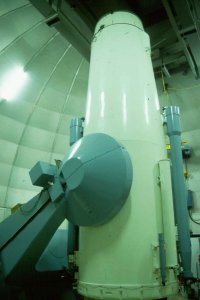Anglo-Australian Observatory


The Anglo-Australian Observatory. In the foreground is the dome of the Anglo-Australian Telescope and in the background, the smaller dome of the UK Schmidt Telescope.

Anglo-Australian Telescope, general view.

Top of the the Anglo-Australian Telescope.
The Anglo-Australian Observatory (AAO) is an observatory that operates the Anglo-Australian Telescope and 1.2-meter (48-inch) United Kingdom Schmidt Telescope on Siding Spring Mountain (at an altitude of 1,150 meters), near Coonabarabran, New South Wales, Australia. Nearby, on the same site, are (or were before a fire in 2003) instruments of the Mount Stromlo and Siding Spring Observatories.
The headquarters and laboratory of the AAO are on the same campus as the Australia Telescope National Facility in the Sydney suburb of Epping.
Anglo-Australian Telescope
The Anglo-Australian Telescope (AAT) is a 3.9-meter (153-inch), equatorially-mounted reflecting telescope located at the Anglo-Australian Observatory. It is the largest optical telescope in Australia.
The AAT came into operation in 1974 and, among many others tasks, is used, in conjunction with a high-resolution échelle
spectrometer, to carry out
the Anglo-Australian Planet Search – an ongoing survey that began in 1998 to search for exoplanets around 240 relatively nearby stars in the southern hemisphere. The AAT was also used in the WiggleZ program, which ran from 2006 to 2011, and also employed NASA's GALEX space telescope to survey the
distribution of about 200,000 galaxies out to distances of 8 billion light-years.
United Kingdom Schmidt Telescope
 |
| The UK Schmidt Telescope
|
The United Kingdom Schmidt Telescope (UKST) is a 1.2-meter Schmidt camera at the Anglo-Australian Observatory. It began operations in 1973. Its initial task was to construct a photographic survey of the entire southern sky. UKST is jointly owned by Britain and Australia.
Recent observing programs
Taipan – A planned survey to measure the Hubble constant to a precision of 1%, measure the bulk flow of galaxies in the nearby Universe in order to better understand cosmology, and to probe some of the lowest mass galaxies in the nearby Universe to understand galaxy formation and evolution.
OzDES – A survey to measure the redshifts of tens of thousands of galaxies and obtain spectra of supernovae and other transients. The galaxy redshifts will be used to make the most detailed measurement of the Universe's expansion history, leading to a better understanding of the physics behind the acceleration of the Universe.
GALAH – A spectroscopic survey of 1 million galactic stars to measure elemental abundances and measure stellar kinematics to understand the formation history of our Milky Way galaxy.
SAMI – A spatially-resolved spectroscopic survey of ~3,000 galaxies, the largest ever to date, to explore the kinematics and internal astrophysical processes of galaxies to understand galaxy formation.
Anglo-Australian Planet Search – The Southern Hemisphere's most precise planet search program.


